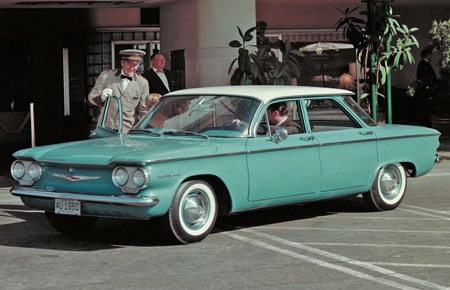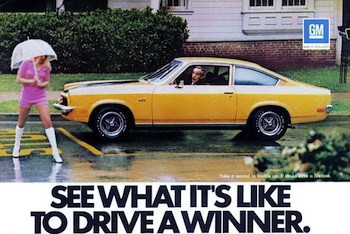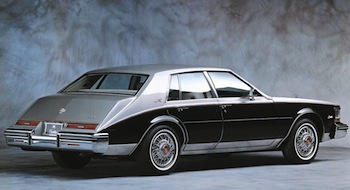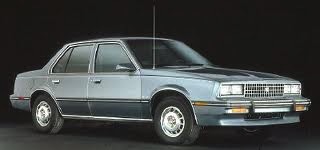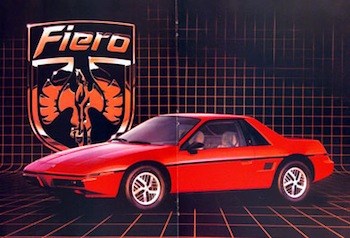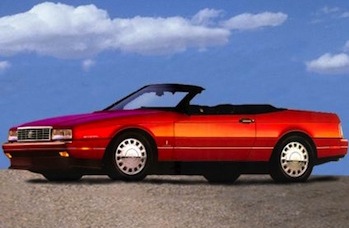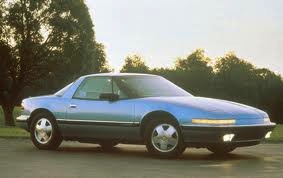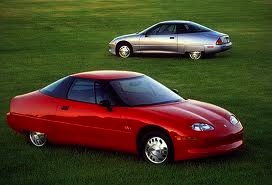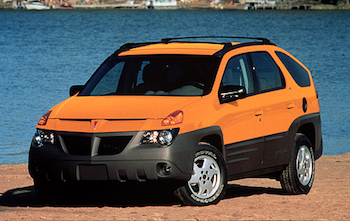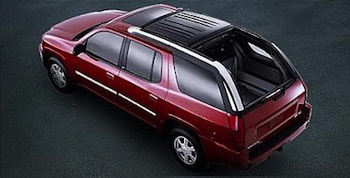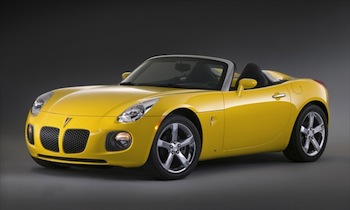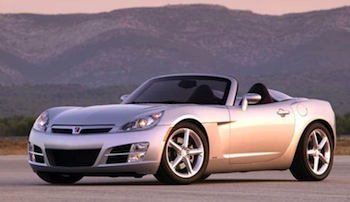General Motors’ Failures – Kudos for Trying
- May 26, 2012
- Buick, Cadillac, Chevrolet, GM, More Categories...
- Posted by George Peterson
- Comments Off on General Motors’ Failures – Kudos for Trying
General Motors Company (formerly “Corporation”) today is a shadow of its former self. It sells fewer models through fewer brands since its bankruptcy in 2009. It is reconstructing itself and building itself into a competitive and profitable car company. That transformation appears to be going very well.
Over the years, however, General Motors has often tried to be a trailblazer (no pun intended) in new vehicle design and development. Many of these vehicles failed, but we believe GM deserves a tremendous amount of credit for trying where other companies did not have the creative thought or resources to make a “segment breaking” product. Here are some examples…
Chevrolet Corvair – 1960-1969 – Beetle Fighter: The Corvair was a reaction to the Volkswagen Beetle that was selling very well in the late ’50s and early 60s. The Corvair had air-cooled rear engine architecture like the Beetle. The first Corvair was essentially killed by Ralph Nader in his book “Unsafe at any Speed”. GM tried to resurrect the Corvair with a second generation that was knock dead gorgeous and remains so today. But Nader’s book had sealed its fate and GM dropped the Corvair after the second generation. About 1.8 million Corvairs were produced at plants across the USA and in South America, Europe and South Africa.
Chevrolet Vega – 1970-1977 – Fighting the Japanese Small Car Onslaught The Vega was another attempt at a General Motors small car. It was launched about the same time as the Ford Pinto. These both were reactions to the Beetle and Japanese small cars that were beginning to be seen in the USA. The Vega was very nicely styled but terribly flawed. Its aluminum block 4-cylinder engine was prone to failure due to overheating. Its body was prone to rust. The Corporation decided that its reputation had become so flawed that a second generation was never launched. Almost 2,000,000 Vegas were produced at GM’s Lordstown, Ohio plant.
Cadillac Seville (2nd Generation – 1980-1985 – Pushing the Envelope in Luxury Styling While the first generation Seville was a classic (even though it was derived from the Chevrolet Nova), the second generation was ponderous and gauche. It had a bustleback rear end (that Ford unfortunately copied for its 1982-1987 Lincoln Continental and Chrysler copied for its 1981-1983 Imperial coupe) that set its styling apart from anything else on the road in 1980. The Seville was victim to GM’s engine experimentation in the early 1980s – unreliable diesels, unreliable and balky V8-6-4 V8s. The Oldsmobile-based diesel established a very poor reputation for diesels in the USA that remains today. The V8-6-4 was way ahead of the technology of its day. In addition to the engine problems, the Seville build quality was suspect at best. About 200,000 of these bustleback Sevilles were produced.
Cadillac Cimarron – 1982-1988 – Giving Cadillac Dealers a Fuel Efficient Small Car The Cimarron was a response to Cadillac dealers’ cries for more fuel efficient cars during the early ’80s fuel crisis. Not having the time or wherewithal to develop a unique car for Cadillac, General Motors quickly derived the Cimarron from the Chevrolet Cavalier. This gave every GM car division at the time a version of the J-Car Platform – Chevrolet Cavalier, Pontiac J2000 (later the Sunbird), Oldsmobile Firenza, Buick Skyhawk and Cadillac Cimarron. Wikipedia cites TIME magazine named the car to its list of the 50 worst cars of all time, stating that the Cimarron represented “[e]verything that was wrong, venal, lazy and mendacious about GM in the 1980s … in [a] flagrant insult to the good name and fine customers of Cadillac,” and that the car “nearly killed Cadillac and remains its biggest shame.” As was GM’s wont at the time, by the time the Cimarron was dropped it had evolved into a reasonably good small car with a V6 engine replacing the original 4-cylinder in its last years. Over seven years in the market, Cimarron sold slightly over 130,000 units.
Pontiac Fiero – 1984-1988 – 2-Seat Commuter Car Launches as a Sports Car Originally conceived as a low priced, fuel efficient commuter car, the two passenger Pontiac Fiero was launched as a mid-engine sports car that did not live up to its billing. Initially, the car sold very well with over 130,000 units produced in its first year. By its final model year, only about 25,000 were produced. The Fiero was difficult to live with; too small and difficult to get into for many drivers. Its engine was prone to overheating and the car initially did not have power steering. Fiero was another example of General Motors finally getting a product right and then killing it. In Fiero’s last model year, 1988, improvements to the powertrain, brakes, steering and suspension yielded a very nice little car. If you are looking for a gem, the final Fiero would be an interesting addition to your consideration list.
Cadillac Allante – 1987-1993 – Fighting Mercedes and Jaguar for Luxury Roadster Buyers The Cadillac Allante was a two-seat luxury sports car with one of the most convoluted production plans ever devised. The body of the Allante was designed and built by Pininfarina in Italy. When the bodies in white were complete, they were loaded into a specially fitted Boeing 747 and air-freighted to the USA where the final assembly was at Cadillac’s Hamtramck Assembly Plant. Aimed to compete with the Mercedes-Benz SL roadster, Cadillac wanted the Allante to be its range topper. The Allante was flawed from the start. Its manual top was impossible to fold. The car leaked. It was prone to electrical problems. By the end, General Motors had dropped the Cadillac Northstar V8 into the 1993 model replacing the anemic 4.1L V8 that powered the early Allantes. The Northstar, combined with numerous detail improvements led the Allante to be a pretty nice car for its last model year – 1993. Over 21,000 Allantes were sold, about half what GM had planned. With a mid-$50,000 price point, the reputation of the Allante never supported robust sales volumes even to the few affluent buyers who would rather have an American roadster instead of a German one.
Buick Reatta – 1989-1992 – Giving Buick an Ego Car The Buick Reatta was a two seat luxury sports car built at GM’s Lansing Craft Centre. Reatta was hand-built in very low volumes with a convertible being added in the 1991 model year. The car was continuously improved and then dropped just when the car had become a competitive product. Reatta is an example of a program that was fueled by management egos rather than determining if a market for this type of car existed at the time it was produced. Over the years about 22,000 Reattas were produced, confirmation that the market for a luxury two-seat sports car from a premium American brand is thin indeed.
Saturn Corporation – 1990-2010 – Experiment in Changing Ways of Doing Business Saturn was a bold experiment by General Motors to reinvent the way they built and sold cars. Initially, Saturn was set up as a subsidiary completely separate from GM with its own staff, corporate headquarters (in Troy, MI) and assembly plant (Spring Hill, TN). The lessons learned at Saturn were supposed to influence General Motors from top to bottom but never did. Saturn adopted no haggle pricing, outstanding sales and service techniques, quirky but effective delivery processes (dealer staff surrounded the new car and buyer for a kumbaya moment on delivery). In the beginning, Saturn was known as having outstanding dealers selling merely OK cars. Women loved buying Saturns because the sales process was non-confrontational. Early Saturn models had plastic body panels that owners loved for their scratch and dent resistance. One reason Saturn adopted plastic panels was that they could be quickly and inexpensively changed for a new look. Never happened. GM starved Saturn for new product and a franchise cannot live on one vehicle alone. By the end, GM had absorbed Saturn back into the corporation but never embraced the learning it could have gained from the experiment. When Saturn was rolled up as part of GM’s bankruptcy they actually had their most competitive lineup ever. Never had a chance.
General Motors (Saturn) EV1 – 1996-1999 – Responding to California ZEV Mandate Way Ahead of Its Time Depending on who you talk to, the EV1 was a tremendous success or an utter failure. It was a billion dollar investment by General Motors to develop a vehicle that met California’s zero emission mandate set go go into effect in 1998. The California mandate was eventually modified no longer requiring zero emitting EVs to meet the regulations. General Motors leased slightly over 1,000 EV1 coupes through designated Saturn dealerships in California and Arizona. The program was terminated in 2002 with all of the cars turned in at lease end. Subsequently, the EV1s were scrapped. The EV1 story remains highly controversial among the avid EV community in Southern California and spurred the movie “Who Killed the Electric Car?” and the 2011 movie “The Revenge of the Electric Car”.
Pontiac Aztek – 2001-2005 – Attempt to Target Young Adventurous Campers “You aren’t supposed to understand the Aztek,” General Motors head of design Wayne Cherry told me before the Aztek was launched. “You are too old.” Well, call that middle aged. The Aztek was based on GM’s European influenced minivan program (also a failure) and because of that heritage could never gain the proportions to make the crossover SUV attractive. As a matter of fact, the Aztek was one of the most hideously styled vehicles to see production during the first decade of the 21st Century. The urban legend within the research community was that Aztek was included in five GM market potential clinics (where up to 2,500 people evaluate up to 25 vehicles to represent the whole USA market) and the Aztek failed completely in each. GM was trying to identify who would buy the Aztek. Clearly, the answer was few. Over its five-year run, slightly over 100,000 Azteks were produced.
GMC Envoy XUV – 2004-2009 – Taking the SUV One Step Farther GMC’s Wagonaire The Envoy XUV was a derivative of the second generation GMC Envoy premium mid-size SUV. The Envoy itself was a very credible SUV and GM sold tons of Envoys and Chevrolet Trailblazers (and lets not forget the Oldsmobile Bravada, Buick Rainier, Isuzu Ascender and Saab 9-7X) and the XUV was a way for GMC to further differentiate itself from the other GM entries. The XUV featured a sliding roof panel over the cargo area that moved forward to provide an open roof. There was a mid-gate in the cargo area that could be raised to separate the cargo area from the seating area. The tailgate was a drop/swing design with a drop glass making the XUV into a vehicle with a small pickup bed for carrying tall items. Studebaker tried this with its Lark Wagonaire in the early ’60s. Didn’t work then either.
Pontiac Solstice (2006-2009) and Saturn Sky (2007-2009) – Bob Lutz Ego Trip Into Market That Isn’t There Initially touted as one of Bob Lutz’ first complete General Motors program, these Kappa platform small sports cars failed on many levels. First, there was very little market for a two seat roadster and the Mazda MX-5 Miata had owned that market for over a decade before the Solstice/Sky were introduced. The Sky was a beautiful execution and certainly better than the ungainly Solstice. Neither looked good with the top up and General Motors resolutely refused to show the cars with the tops up at any reviews or auto shows. These were extraneous products that used resources General Motors could have applied better elsewhere. Think of Solstice/Sky as an example of the kind of programs that sapped General Motors creative and financial strength over the years. Bob Lutz is not infallible.
 Hummer – 1999-2010 – Pushing the SUV Envelope Too Late With Too Much Designed to capitalize on the popularity of the military Humvee in the first Gulf War, General Motors acquired the Hummer name from AM General the maker of the original Humvee in 1999. AM General manufactured the original, the H1, and also the General Motors derived H2. The H2 was the cornerstone of the franchise and was launched for the 2003 model year. Initial sales were robust as American buyers embraced the super-macho styling and bulk of the H2. Sales of the H2 peaked in 2003 at about 35,000 units and began tailing off as the brand became a lightning rod for criticism by environmentalists and the anti-SUV lobby. Hummer died an ignominious death as General Motors went through bankruptcy. For a moment it appeared that a Chinese manufacturing company would buy the brand, but the Chinese government nixed the deal and Hummer “went away”. Unfortunately, just prior to its demise, Hummer began an aggressive dealership upgrade program that convinced many Hummer dealers to add expensive new showrooms. Those multi-million dollar investments were depreciated immediately as the dealers tried to find new uses for them.
Hummer – 1999-2010 – Pushing the SUV Envelope Too Late With Too Much Designed to capitalize on the popularity of the military Humvee in the first Gulf War, General Motors acquired the Hummer name from AM General the maker of the original Humvee in 1999. AM General manufactured the original, the H1, and also the General Motors derived H2. The H2 was the cornerstone of the franchise and was launched for the 2003 model year. Initial sales were robust as American buyers embraced the super-macho styling and bulk of the H2. Sales of the H2 peaked in 2003 at about 35,000 units and began tailing off as the brand became a lightning rod for criticism by environmentalists and the anti-SUV lobby. Hummer died an ignominious death as General Motors went through bankruptcy. For a moment it appeared that a Chinese manufacturing company would buy the brand, but the Chinese government nixed the deal and Hummer “went away”. Unfortunately, just prior to its demise, Hummer began an aggressive dealership upgrade program that convinced many Hummer dealers to add expensive new showrooms. Those multi-million dollar investments were depreciated immediately as the dealers tried to find new uses for them.

